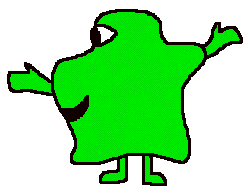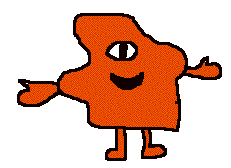Answers to the more specific questions:
Questions about 4D people
1. How would your backpack look different to a 4-D person? they could
see the stuff inside it without opening it
2. Could a 4D person take a memory chip out of the computer in our classroom
without opening the case? Yes, they could reach in and take it out in
a direction that would go out of our 3D universe
or I could ask a very general question:
4. Explain something that would look different to a 4D person, and how it
would look. You could explain about a backpack or a present or a computer
or ...
5. p. 321 # 4 is a pretty good example . The answer to #4 is that a 2D
person would have to tear barriers of3 and 4 to take the gold bar out. A 3D
person wouldn't have any problems though, and could lift the gold out by taking
it out of the 2D universe by pulling it up into the third dimension. If they
did that, and a 2D person was watching, it would look like the gold bar just
disappeared.
6. Draw a box that a 2D person couldn't look inside, but a 3D person could
Draw something like the first two safes in #5
6 1/2. Which of these two pictures would make the better 2-D person? Why?


The green guy (on the left) would be better because he can see things
in his universe with his eye, and he can eat/talk to things in his universe
with his mouth. The orange guy would be blind to things in his universe because
his eye isn't pointing out into his universe from his body.
1D: a 1D universe is really boring because you can only go forwards and backwards.
You can only see things right in front or right behind you. If you were a 1D
person there would probably be a lot of your universe you couldn't see or get
to.
Some questions I could ask are:
7. If you were a 1D person, how many other 1D people could you see directly?
Not very many. Probably two--one in front and one behind you. It's possible
that you could see only 1 or 0 people. If you lived in a really unusual universe
(say, theta-shaped) there might be a few more, but that would be a really
different sort of place than we experimented with in class.
8. describe what a 1D universe is like: I repeat myself: a 1D universe
is really boring because you can only go forwards and backwards. You can only
see things right in front or right behind you. If you were a 1D person there
would probably be a lot of your universe you couldn't see or get to. Additionally
or instead you might say: In a 1D universe you can only go forwards or
backwards, and you can't go around anything that's in your way so it's easy
to get stuck.
You can see an illustration (the best you're likely to get) on page 314 near
the bottom of the page. With a little care, you should be able to figure out
how to sketch it well enough to count vertices and edges. There are 16 vertices
and 32 edges.
The question I am most likely to ask is:
9. Tell how many vertices and edges a 4D cube has. Tell how you know. You
would say, of course, that there were 16 vertices and 32 edges. You could
explain your answer by sketching a 4-cube and inviting your reader to count
the vertices and edges. If you are not artistically inclined, you could argue
that a 3D cube has 8 vertices, and since a 4D cube is two 3D cubes connected
by some edges and faces, a 4D cube would have as many vertices as two 3D cubes,
which would be 16. For the edges, you'd have to count the edges on both of
the 3D cubes (that makes 24), and then add on an edge for each pair of vertices
that are connected by fourth dimensional edges (that would be 8 more) to get
a total of 32.

